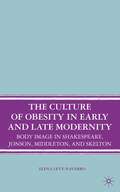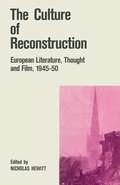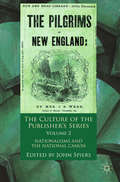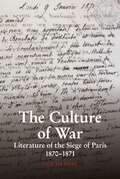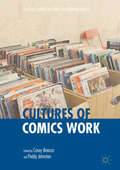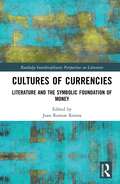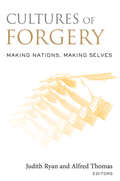- Table View
- List View
The Culture of Obesity in Early and Late Modernity: Body Image in Shakespeare, Jonson, Middleton, and Skelton
by E. Levy-NavarroThis book offers the first sustained examination of fatness in the early modern period. Using readings of such major figures as Shakespeare, Jonson, Middleton, and Skelton, this book considers alternative ways that fat was constructed before the introduction of the modern pathologized category of 'obesity'.
The Culture of Reconstruction: European Literature, Thought and Film, 1945–50 (pdf) (Warwick Studies in the European Humanities)
by Nicholas Hewitt Sarah WassermanThe Culture of Sentiment: Race, Gender, and Sentimentality in 19th-Century America
by Shirley SamuelsSamuels's collection of critical essays gives body and scope to the subject of nineteenth-century sentimentality by situating it in terms of "women's culture" and issues of race. Presenting an interdisciplinary range of approaches that consider sentimental culture before and after the Civil War, these critical studies of American literature and culture fundamentally reorient the field. Moving beyond alignment with either pro- or anti-sentimentality camps, the collection makes visible the particular racial and gendered forms that define the aesthetics and politics of the culture of sentiment. Drawing on the fields of American cultural history, American studies, and literary criticism, the contributors include Lauren Berlant, Ann Fabian, Susan Gillman, Karen Halttunen, Carolyn L. Karcher, Joy Kasson, Amy Schrager Lang, Isabelle Lehuu, Harryette Mullen, Dana Nelson, Lora Romero, Shirley Samuels, Karen Sanchez-Eppler, Lynn Wardley, and Laura Wexler.
The Culture of Soft Work: Labor, Gender, and Race in Postmodern American Narrative (American Literature Readings in the 21st Century)
by H. HicksThe Culture of Soft Work examines American writers' responses to human resource management and motivational techniques in the workplace through readings of postmodern novels and a diverse range of other canonical and popular texts.
The Culture of the Body: Genealogies of Modernity (The Body, In Theory: Histories of Cultural Materialism)
by Dalia JudovitzWhat is the body? How was it culturally constructed, conceived, and cultivated before and after the advent of rationalism and modern science? This interdisciplinary study elaborates a cultural genealogy of the body and its legacies to modernity by tracing its crucial redefinition from a live anatomical entity to disembodied, mechanical and virtual analogs. The study ranges from Baroque, pre-Cartesian interpretations of body and embodiment, to the Cartesian elaboration of ontological difference and mind-body dualism, and it concludes with the parodic and violent aftermath of this legacy to the French Enlightenment. It engages work by philosophical authors such as Montaigne, Descartes and La Mettrie, as well as literary works by d'Urfé, Corneille and the Marquis de Sade. The examination of sexuality and the emergence of sexual difference as a dominant mode of embodiment are central to the book's overall design. The work is informed by philosophical accounts of the body (Nietzsche, Foucault, Merleau-Ponty), by feminist theory (Butler, Irigaray, Bordo), as well as by literary and cultural historians (Scarry, Stewart, Bynum, etc.) and historians of science (Canguilhem, Pagel, and Temkin), among others. It will appeal to scholars of literature, philosophy, French studies, critical theory, feminist theory, cultural historians and historians of science and technology. Dalia Judovitz is Professor of French, Emory University. She is also author of Unpacking Duchamp: Art in Transit and Subjectivity and Representation in Decartes: The Origins of Modernity.
The Culture of the Gift in Eighteenth-Century England
by C. KlekarThe Culture of the Gift in Eighteenth-Century England analyzes the long overlooked role of gift exchange in literary texts and cultural documents and provides innovative readings of how gift transactions shaped the institutions and practices that gave this era its distinctive identity.
The Culture of the Horse: Status, Discipline, and Identity in the Early Modern World (Early Modern Cultural Studies 1500–1700)
by K. Raber T. TuckerThis volume fills an important gap in the analysis of early modern history and culture by reintroducing scholars to the significance of the horse. A more complete understanding of the role of horses and horsemanship is absolutely crucial to our understanding of the early modern world. Each essay in the collection provides a snapshot of how horse culture and the broader culture - that tapestry of images, objects, structures, sounds, gestures, texts, and ideas - articulate. Without knowledge of how the horse figured in all these aspects, no version of political, material, or intellectual culture in the period can be entirely accurate.
The Culture of the Publisher's Series, Volume 2: Nationalisms and the National Canon
by John SpiersThis volume explores problems concerning the series, national development and the national canon in a range of countries and their international book-trade relationships. Studies focus on issues such as the fabrication of a national canon, and on the book in war-time, the evolution of Catholic literature, imperial traditions and colonial libraries.
The Culture of the Publisher’s Series, Volume One: Authors, Publishers and the Shaping of Taste
by John SpiersThis volume focuses on the publisher's series as a cultural formation - a material artefact and component of cultural hierarchies. Contributors engage with archival research, cultural theory, literary and bibliometric analysis (amongst a range of other approaches) to contextualize the publisher's series in terms of its cultural and economic work.
The Culture of Translation in Early Modern England and France, 1500-1660 (Early Modern Literature in History)
by Tania Demetriou Rowan TomlinsonThis book explores modalities and cultural interventions of translation in the early modern period, focusing on the shared parameters of these two translation cultures. Translation emerges as a powerful tool for thinking about community and citizenship, literary tradition and the classical past, certitude and doubt, language and the imagination.
The Culture of Usury in Renaissance England
by D. HawkesThis book examines the ways in which usury was perceived and portrayed as it rose to popularity in Renaissance England, taking into account the works of key literary figures of this period, including Milton and Shakespeare.
The Culture of War: Literature of the Siege of Paris 1870-1871 (Studies in Modern and Contemporary France #6)
by Colin FossThe Culture of War explores the unexpected flourishing of literature both high and low during the Siege of Paris at the end of the Franco-Prussian War, 1870-1871. When Prussian forces completely blockaded Paris, isolating the city from the outside world, Parisians turned to literature to resist the enemy, to fill the idle hours under siege, and to articulate their place in history. This cultural boom was a conscious effort on the part of literary institutions like newspapers, publishers, and theaters to ensure the viability of their industries during a period of political uncertainty. To do so, many publishers, editors, and directors sought legitimacy through populism, promoting literature written by anonymous and unknown authors or that spoke to populist ideas. A study of national tragedy on a local scale, The Culture of War goes beyond traditional narratives of communal or individual psychology, and studies institutional responses to financial and political instability, viewing literature as a product of economic and political forces.
The Culture of Yellow: Or, The Visual Politics of Late Modernity
by Sabine DoranThis is the first book to explore the cultural significance of the color yellow, showing how its psychological and aesthetic value marked and shaped many of the intellectual, political, and artistic currents of late modernity. It contends that yellow functions during this period primarily as a color of stigma and scandal.Yellow stigmatization has had a long history: it goes back to the Middle Ages when Jews and prostitutes were forced to wear yellow signs to emphasize their marginal status. Although scholars have commented on these associations in particular contexts, Sabine Doran offers the first overarching account of how yellow connects disparate cultural phenomena, such as turn-of-the-century decadence (the "yellow nineties"), the rise of mass media ("yellow journalism"), mass immigration from Asia ("the yellow peril"), and mass stigmatization (the yellow star that Jews were forced to wear in Nazi Germany). The Culture of Yellow combines cultural history with innovative readings of literary texts and visual artworks, providing a multilayered account of the unique role played by the color yellow in late nineteenth- and twentieth-century American and European culture.
The Culture of Yellow: Or, The Visual Politics of Late Modernity
by Sabine DoranThis is the first book to explore the cultural significance of the color yellow, showing how its psychological and aesthetic value marked and shaped many of the intellectual, political, and artistic currents of late modernity. It contends that yellow functions during this period primarily as a color of stigma and scandal.Yellow stigmatization has had a long history: it goes back to the Middle Ages when Jews and prostitutes were forced to wear yellow signs to emphasize their marginal status. Although scholars have commented on these associations in particular contexts, Sabine Doran offers the first overarching account of how yellow connects disparate cultural phenomena, such as turn-of-the-century decadence (the "yellow nineties"), the rise of mass media ("yellow journalism"), mass immigration from Asia ("the yellow peril"), and mass stigmatization (the yellow star that Jews were forced to wear in Nazi Germany). The Culture of Yellow combines cultural history with innovative readings of literary texts and visual artworks, providing a multilayered account of the unique role played by the color yellow in late nineteenth- and twentieth-century American and European culture.
Culture Writing: Literature and Anthropology in the Midcentury Atlantic World (Modernist Literature and Culture)
by Tim WatsonFocusing on the 1950s and early 1960s, Culture Writing argues that this period in Britain, the United States, France, and the Caribbean was characterized by dynamic exchanges between literary writers and anthropologists on both sides of the Atlantic. As the British and French empires collapsed and the United States rose to global power in the early Cold War, and as intellectuals from the decolonizing world challenged the cultural hegemony of the West, some anthropologists began to assess their discipline's complicity with empire and experimented with literary forms and technique. Culture Writing shows that the "literary turn" in anthropology took place earlier than has conventionally been assumed, in the 1950s rather than the 1970s and 80s. Simultaneously, some literary writers reacted to the end of the period of modernist experimentation by turning to ethnographic methods for representing the people and cultural practices of Britain, France, and the United States, bringing anthropology back home. There is analysis of literary writers who had a significant professional engagement with anthropology and brought some of its techniques and research questions into literary composition: Barbara Pym (Britain), Ursula Le Guin and Saul Bellow (United States), Édouard Glissant (Martinique), and Michel Leiris (France). On the side of ethnography, the book analyzes works by anthropologists who either explicitly or surreptitiously adopted literary forms for their writing about culture: Laura Bohannan (United States), Michel Leiris and Claude Lévi-Strauss (France), and Mary Douglas (Britain). Culture Writing concludes with an epilogue that shows how the literature-anthropology conversation continues into the postcolonial period in the work of Indian author-anthropologist Amitav Ghosh and Jamaican author-sociologist Erna Brodber.
Culture Writing: Literature and Anthropology in the Midcentury Atlantic World (Modernist Literature and Culture)
by Tim WatsonFocusing on the 1950s and early 1960s, Culture Writing argues that this period in Britain, the United States, France, and the Caribbean was characterized by dynamic exchanges between literary writers and anthropologists on both sides of the Atlantic. As the British and French empires collapsed and the United States rose to global power in the early Cold War, and as intellectuals from the decolonizing world challenged the cultural hegemony of the West, some anthropologists began to assess their discipline's complicity with empire and experimented with literary forms and technique. Culture Writing shows that the "literary turn" in anthropology took place earlier than has conventionally been assumed, in the 1950s rather than the 1970s and 80s. Simultaneously, some literary writers reacted to the end of the period of modernist experimentation by turning to ethnographic methods for representing the people and cultural practices of Britain, France, and the United States, bringing anthropology back home. There is analysis of literary writers who had a significant professional engagement with anthropology and brought some of its techniques and research questions into literary composition: Barbara Pym (Britain), Ursula Le Guin and Saul Bellow (United States), Édouard Glissant (Martinique), and Michel Leiris (France). On the side of ethnography, the book analyzes works by anthropologists who either explicitly or surreptitiously adopted literary forms for their writing about culture: Laura Bohannan (United States), Michel Leiris and Claude Lévi-Strauss (France), and Mary Douglas (Britain). Culture Writing concludes with an epilogue that shows how the literature-anthropology conversation continues into the postcolonial period in the work of Indian author-anthropologist Amitav Ghosh and Jamaican author-sociologist Erna Brodber.
Cultures and Literatures in Dialogue: The Narrative Construction of Russian Cultural Memory (Routledge Studies in Nineteenth Century Literature)
by Elena BollingerThis book addresses the narrative construction of Russian cultural memory in the work of Julian Barnes. It investigates how Barnes's texts tend to display a memory process as a transcultural mode of the creation of English and Russian national identities. Examining a need to revisit Russian canonical works, the detailed discursive analysis of the selected English texts exposes an intertextual remembering by duplication, thus contributing to the prevention of forgetting through the recuperation of still misrecollected cultural meanings. By creatively incorporating Russian intertextual elements into his work as a novelist, the author seems to insist on sweeping across and beyond national boundaries, revealing how frail the invention of tradition is when leading to the illusion of a solid collective memory and its political legitimation. The book considers not only a constructive dialogue between Barnes’s fiction and Russian classical literature, but also this writer’s interpretative, mostly imaginative, integration of Russian literature and culture into his work as a novelist. Exploring the double meaning of a literary metaphor as a mnemonic image of memory and a product of imagination, it offers a comprehensive analysis of Barnes’s texts which play with intertextuality as an efficient tool of displacement of official memory, providing a deeper understanding of historical and cultural processes related to the constantly moving architecture of transcultural memory.
Cultures and Literatures in Dialogue: The Narrative Construction of Russian Cultural Memory (Routledge Studies in Nineteenth Century Literature)
by Elena BollingerThis book addresses the narrative construction of Russian cultural memory in the work of Julian Barnes. It investigates how Barnes's texts tend to display a memory process as a transcultural mode of the creation of English and Russian national identities. Examining a need to revisit Russian canonical works, the detailed discursive analysis of the selected English texts exposes an intertextual remembering by duplication, thus contributing to the prevention of forgetting through the recuperation of still misrecollected cultural meanings. By creatively incorporating Russian intertextual elements into his work as a novelist, the author seems to insist on sweeping across and beyond national boundaries, revealing how frail the invention of tradition is when leading to the illusion of a solid collective memory and its political legitimation. The book considers not only a constructive dialogue between Barnes’s fiction and Russian classical literature, but also this writer’s interpretative, mostly imaginative, integration of Russian literature and culture into his work as a novelist. Exploring the double meaning of a literary metaphor as a mnemonic image of memory and a product of imagination, it offers a comprehensive analysis of Barnes’s texts which play with intertextuality as an efficient tool of displacement of official memory, providing a deeper understanding of historical and cultural processes related to the constantly moving architecture of transcultural memory.
Culture's Consequences: Comparing Values, Behaviors, Institutes and Organizations across Nations (The Macat Library)
by Katherine ErdmanThe Dutch anthropologist Geert Hofstede is recognized as a pioneer in the fields of international management and social psychology – and his work is a perfect example of the ways in which interpretative skills can help solve problems and provide the foundation for strong thinking and understanding both in business and beyond. Hofstede’s central achievement was setting up an efficient interpretative framework for understanding the cultural differences between one country and another. Working for the international computing company IBM in the late 1960s, Hofstede noted that such cultural differences had huge consequences for international organizations. Up until then, while many inside and outside of business recognized the importance of these differences, little had been done to define precisely what cultural difference was and in what areas of life it was expressed. Hofstede’s insight was that if one could interpret and define the dimensions of cultural difference, it would be possible to measure them and act accordingly. From a vast survey of IBM’s employees in several countries, Hofstede originally defined five dimensions of culture: every society could be rated for each dimension, providing a useful guide to the kinds of cultural differences at play. As ever, good interpretative skills provided the basis for better understanding.
Culture's Consequences: Comparing Values, Behaviors, Institutes and Organizations across Nations (The Macat Library)
by Katherine ErdmanThe Dutch anthropologist Geert Hofstede is recognized as a pioneer in the fields of international management and social psychology – and his work is a perfect example of the ways in which interpretative skills can help solve problems and provide the foundation for strong thinking and understanding both in business and beyond. Hofstede’s central achievement was setting up an efficient interpretative framework for understanding the cultural differences between one country and another. Working for the international computing company IBM in the late 1960s, Hofstede noted that such cultural differences had huge consequences for international organizations. Up until then, while many inside and outside of business recognized the importance of these differences, little had been done to define precisely what cultural difference was and in what areas of life it was expressed. Hofstede’s insight was that if one could interpret and define the dimensions of cultural difference, it would be possible to measure them and act accordingly. From a vast survey of IBM’s employees in several countries, Hofstede originally defined five dimensions of culture: every society could be rated for each dimension, providing a useful guide to the kinds of cultural differences at play. As ever, good interpretative skills provided the basis for better understanding.
Cultures of Comics Work (Palgrave Studies in Comics and Graphic Novels)
by Casey Brienza Paddy JohnstonThis anthology explores tensions between the individualistic artistic ideals and the collective industrial realities of contemporary cultural production with eighteen all-new chapters presenting pioneering empirical research on the complexities and controversies of comics work. Art Spiegelman. Alan Moore. Osamu Tezuka. Neil Gaiman. Names such as these have become synonymous with the medium of comics. Meanwhile, the large numbers of people without whose collective action no comic book would ever exist in the first place are routinely overlooked. Cultures of Comics Work unveils this hidden, global industrial labor of writers, illustrators, graphic designers, letterers, editors, printers, typesetters, publicists, publishers, distributors, translators, retailers, and countless others both directly and indirectly involved in the creative production of what is commonly thought of as the comic book. Drawing upon diverse theoretical and methodological perspectives, an international and interdisciplinary cohort of cutting-edge researchers and practitioners intervenes in debates about cultural work and paves innovative directions for comics scholarship.
Cultures of Currencies: Literature and the Symbolic Foundation of Money (Routledge Interdisciplinary Perspectives on Literature)
by Joan Ramon ResinaThis book’s premise is not only the commonly accepted cultural relativity of economic concepts, but also the observation that the current shift in the meaning of concepts like “market,” “currency,” “exchange,” and “money” suggests that culture is undergoing a change with unpredictable economic and political consequences. The essays in the book raise basic questions concerning exchange – what is exchanged, who exchanges and how, which kind of currency is used, and indeed what is money and how does it convey and retain value over time. These issues are all classical objects of economic theory, but less often have they been approached from a cultural perspective. Works treating economic and monetary issues from a cultural perspective are few and far apart, and this book aims to contribute to such a perspective with a variety of approaches.
Cultures of Currencies: Literature and the Symbolic Foundation of Money (Routledge Interdisciplinary Perspectives on Literature)
by Joan Ramon ResinaThis book’s premise is not only the commonly accepted cultural relativity of economic concepts, but also the observation that the current shift in the meaning of concepts like “market,” “currency,” “exchange,” and “money” suggests that culture is undergoing a change with unpredictable economic and political consequences. The essays in the book raise basic questions concerning exchange – what is exchanged, who exchanges and how, which kind of currency is used, and indeed what is money and how does it convey and retain value over time. These issues are all classical objects of economic theory, but less often have they been approached from a cultural perspective. Works treating economic and monetary issues from a cultural perspective are few and far apart, and this book aims to contribute to such a perspective with a variety of approaches.
Cultures of Economy in South-Eastern Europe: Spotlights and Perspectives (Edition Kulturwissenschaft #220)
by Jurij Murasov Davor Beganovic Andrea LesicThe ubiquitous »cultural turn« of the 1990s did not spare the thinkers of economics - however, at the same time, economic topics have gained a new importance in cultural studies. This volume focuses on cultures of economy in regions of former Yugoslavia as part of South-Eastern Europe, supported by theoretical perspectives. It examines narratives and poetics of economy in literature, film, and art, as well as in public discourse. The contributors spotlight different historical periods: the late 19th and the early 20th centuries, Socialist Yugoslavia and the transitional and neoliberal period since the 1990s.
Cultures of Forgery: Making Nations, Making Selves (CultureWork: A Book Series from the Center for Literacy and Cultural Studies at Harvard)
by Judith Ryan Alfred ThomasIn Cultures of Forgery, leading literary studies and cultural studies scholars examine the double meaning of the word "forge"-to create or to form, on the one hand, and to make falsely, on the other.
